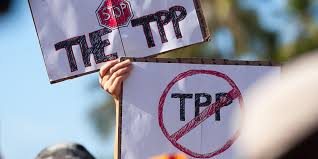In America’s absence, Japan takes the lead on free trade

East Asia Forum | 1 March 2018
In America’s absence, Japan takes the lead on free trade
by Yoichi Funabashi
At a time when Japan is doing more than ever to uphold the post-war international system, it is an extreme historical irony that the Greater East Asia Co-Prosperity Sphere of Imperial Japan is finally being achieved. Japan’s leadership in obtaining signatures on the final agreement of the Comprehensive and Progressive Agreement for Trans-Pacific Partnership (CPTPP), also known as TPP-11, will be a big step toward Asian regionalism without the United States.
Japan’s core plan had always been for TPP and the Asia Pacific to include the United States. Since World War II, Japan has for the most part sought an Asia Pacific fusion through the US–Japan alliance. Japan refused to participate in initiatives without the United States’ participation (such as the East Asia Economic Caucus) and it supported US-inclusive frameworks like the Asia Pacific Economic Cooperation forum and the East Asia Summit. The guiding principle was to keep the United States engaged in Asia.
The Japanese government is still hoping for a multilateral Asia Pacific order that includes the United States. Japanese Deputy Prime Minister Taro Aso confided to US Vice President Mike Pence in early February that Japan encourages a US return to the TPP. But Pence’s response was to raise the Trump administration’s wish for a US–Japan bilateral free trade agreement — something that is unwelcome in Japan.
On the ground, opposition to US reintegration among CPTPP members is spreading. The Trump administration has made clear that any possible return to the TPP would require renegotiation of the deal with the renegotiation favouring US interests beyond the original agreement. That would necessitate concessions that member countries would flatly refuse.
Were the United States to find the original agreement terms palatable and attempt to return, that too would be tough. The CPTPP has suspended 22 TPP clauses that had previously been swallowed by developing countries in exchange for US market access, such as investor–state dispute mechanisms and intellectual property and labour requirements. The Trump administration could push for additional clauses, for example concerning currency, when returning to the TPP framework. But with Japanese Prime Minister Shinzo Abe adamantly opposed, that is a lost cause. Even if only the 22 suspended clauses are reactivated, the political costs for developing countries like Vietnam could become unacceptably high relative to the less demanding CPTPP.
The United States is highly unlikely to return to the deal during or even beyond the Trump administration. But the world will not stop simply because of US disengagement.
CPTPP countries look set to ratify the deal by 2019. After reaching an agreement in principle last year, Japan and the European Union are aiming for their Economic Partnership Agreement (EPA) to come into force by early 2019. Japanese focus will then turn to the Regional Comprehensive Economic Partnership (RCEP). Japan’s mission is to incorporate India through RCEP into Asia’s trade liberalisation regime.
If successful, the economic gains of both the CPTPP and RCEP will be significant. But their real value is in providing frameworks to uphold the liberal international order and realise a free and open Asia Pacific region. Rule making, rule of law, multilateralism and international cooperation are vital elements to support those two visions, facilitate market access and counteract market-distorting trade practices and state capitalism.
Japan’s international economic leadership today — a hop, step and jump through the Japan–EU EPA, CPTPP and RCEP — is happening without the US.
Taking on regional leadership without the United States has been geopolitically tricky for post-war Japan. Its initiative to set up the Asian Monetary Fund after the Asian financial crisis in the late 1990s was shut down by the United States and then China. But with the CPTPP, Japan has managed to shake off that negative legacy. So far, neither the United States nor China has opposed Japan’s step up.
Nevertheless, Japan’s lurking fear is that an Asian regionalism that excludes the United States could push Washington to be further inward-looking. Deeper US engagement in Asia is indispensable to balance China, and the TPP desperately needs the US market to have strategic significance. Opinion in Tokyo is polarised on whether the United States should be tethered to the TPP by whatever means necessary — even a bilateral deal with Japan or a rebranding of the TPP to placate Trump as part of a ‘Trump Pacification Plot’.
Uncertainty over US involvement is pushing the Japanese government to hedge. Motivated further by the tensions on the Korean Peninsula, Abe has been pushing to improve China–Japan relations. And the concentration of Xi Jinping’s power in China has unexpectedly facilitated Beijing’s acceptance of friendliness toward Japan. The stabilisation of relations is paving the way for mutual head of state visits, something that was unthinkable in 2010.
The result is the emergence of a new regional order without the United States. Japan’s aim is not to oppose or contain China but instead to fill the US void in economic and rule-making terms, in partnership with Asia Pacific countries.
What becomes less clear in this emerging Asian regionalism is the matter of security. East Asia has become the region with the highest potential for geopolitical instability with global implications. With the existential threat on the Korean Peninsula and a confident, assertive China, there is a need for more robust Japanese national security policy. Yet Japan’s central vision here, too, remains anchored in Asia Pacific fusion through the US–Japan alliance. Since economics and security cannot be neatly partitioned, deep regional economic engagement by the United States remains essential.





